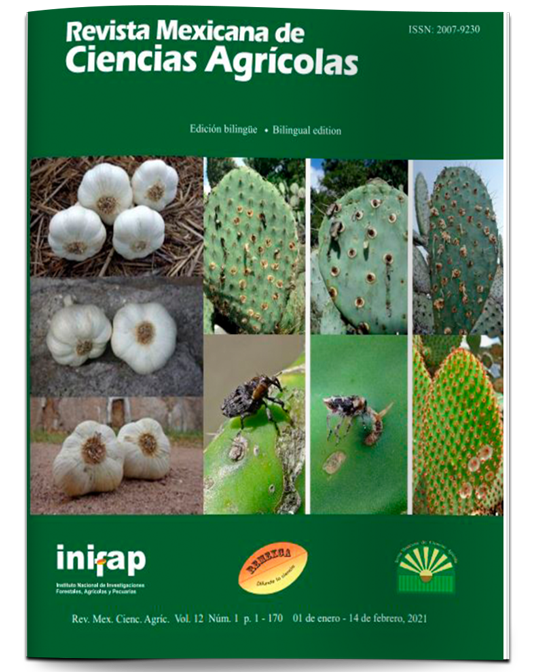Quantification of enzymes related to insecticide resistance in Bemisia tabaci from the state of Sinaloa
DOI:
https://doi.org/10.29312/remexca.v12i1.2504Keywords:
Bemisia tabaci, Insecticides, ResistanceAbstract
The whitefly Bemisia tabaci (Gennadius) is one of the most invasive pests and causes direct damage to crop by feeding on the sap and indirect damage by being a vector of more than 100 phytopathogenic viruses. At present its control is based on the use of chemical insecticides, because the populations have been constantly subjected to a high selection pressure. An alternative that contributes to understanding the origin of resistance in a population are biochemical tests, which show the parameter of the detoxifying enzyme present. The objective of the present work was the quantification of these enzymes in B. tabaci in the three main solanaceae producing areas of the north (Guasave, Sinaloa de Leyva, Mochis), center (Culiacán, Navolato, Elota) and south (Concordia, Rosario, Esquinapa) of the state of Sinaloa. Whitefly adults were collected at these sites and the enzymatic levels of α and β esterases, glutathione S-transferases, aceticolinesterases and oxidases were determined, additionally a susceptible laboratory line was used as a reference. The enzymes with the highest presence were α-esterases, β-esterases and oxidases, followed by glutathione S-transferases and acetylcholinesterase. Therefore, it is concluded that resistance to insecticides in B. tabaci in the state of Sinaloa is due to the high content of α - β-esterases and oxidases, while acetylcholinesterase is not a relevant mechanism in the populations of this producing region.
Downloads
Published
How to Cite
Issue
Section
License
Copyright (c) 2021 Revista Mexicana de Ciencias Agrícolas

This work is licensed under a Creative Commons Attribution-NonCommercial 4.0 International License.
The authors who publish in Revista Mexicana de Ciencias Agrícolas accept the following conditions:
In accordance with copyright laws, Revista Mexicana de Ciencias Agrícolas recognizes and respects the authors’ moral right and ownership of property rights which will be transferred to the journal for dissemination in open access. Invariably, all the authors have to sign a letter of transfer of property rights and of originality of the article to Instituto Nacional de Investigaciones Forestales, Agrícolas y Pecuarias (INIFAP) [National Institute of Forestry, Agricultural and Livestock Research]. The author(s) must pay a fee for the reception of articles before proceeding to editorial review.
All the texts published by Revista Mexicana de Ciencias Agrícolas —with no exception— are distributed under a Creative Commons License Attribution-NonCommercial 4.0 International (CC BY-NC 4.0), which allows third parties to use the publication as long as the work’s authorship and its first publication in this journal are mentioned.
The author(s) can enter into independent and additional contractual agreements for the nonexclusive distribution of the version of the article published in Revista Mexicana de Ciencias Agrícolas (for example include it into an institutional repository or publish it in a book) as long as it is clearly and explicitly indicated that the work was published for the first time in Revista Mexicana de Ciencias Agrícolas.
For all the above, the authors shall send the Letter-transfer of Property Rights for the first publication duly filled in and signed by the author(s). This form must be sent as a PDF file to: revista_atm@yahoo.com.mx; cienciasagricola@inifap.gob.mx; remexca2017@gmail.
This work is licensed under a Creative Commons Attribution-Noncommercial 4.0 International license.



